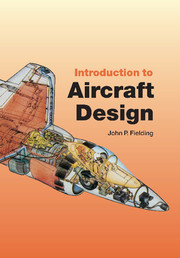Book contents
- Frontmatter
- Contents
- Preface
- Acknowledgements
- 1 Introduction
- 2 Why should we design a new aircraft?
- 3 Why is it that shape? – Civil aircraft
- 4 Why is it that shape? – Other types
- 5 What's under the skin? – Structure and propulsion
- 6 What's under the skin? – Airframe systems
- 7 What's under the skin? – Avionics, flight control and weapon systems
- 8 Why do aircraft cost so much?
- 9 What help can I get? – Bibliography and computer-aided design
- 10 The shape of things to come – Should the project continue?
- 11 What can go wrong? – Some lessons from past aircraft projects, and a glimpse into the future
- Appendix A Useful aircraft design data
- Appendix B A–90 parametric study. Example – the A-90 500-seat airliner
- Appendix C The prediction of aircraft reliability and maintainability targets
- References
- Index
2 - Why should we design a new aircraft?
- Frontmatter
- Contents
- Preface
- Acknowledgements
- 1 Introduction
- 2 Why should we design a new aircraft?
- 3 Why is it that shape? – Civil aircraft
- 4 Why is it that shape? – Other types
- 5 What's under the skin? – Structure and propulsion
- 6 What's under the skin? – Airframe systems
- 7 What's under the skin? – Avionics, flight control and weapon systems
- 8 Why do aircraft cost so much?
- 9 What help can I get? – Bibliography and computer-aided design
- 10 The shape of things to come – Should the project continue?
- 11 What can go wrong? – Some lessons from past aircraft projects, and a glimpse into the future
- Appendix A Useful aircraft design data
- Appendix B A–90 parametric study. Example – the A-90 500-seat airliner
- Appendix C The prediction of aircraft reliability and maintainability targets
- References
- Index
Summary
The world has accepted that flying is an extremely efficient means of quickly transporting people, cargo or equipment, and performing a wide range of other activities. All operators need to increase efficiency, cost-effectiveness, environmental compatibility and safety. It is often possible to do this by modifying either the design or operation of existing aircraft. This is limited, however, by the inherent capabilities of the original design and the cost-effectiveness of modifications. Under these circumstances, it is necessary to consider the initiation of the design of a new aircraft. Aircraft manufacturers are usually in the business of making profit out of building aircraft. They may do this by means of building their own existing designs, modifying their designs or licence-building the designs of other companies. Another reason for the initiation of new designs is to retain or enhance their design capabilities.
Requirements and aircraft specifications come from a number of different sources, but they must all consider the needs of the aircraft operators, whether they are airlines or air forces. A certain path to disaster is to produce an aircraft that no one will buy!
Descriptions will be given of the two main means of deriving a requirement specification, namely the results of market surveys and individual aircraft operators' specifications.
Market surveys
The major aircraft manufacturers employ marketing departments which produce annual reports [2]. Historical data are analysed and extrapolated in such areas as world economic indicators.
- Type
- Chapter
- Information
- Introduction to Aircraft Design , pp. 7 - 18Publisher: Cambridge University PressPrint publication year: 1999

